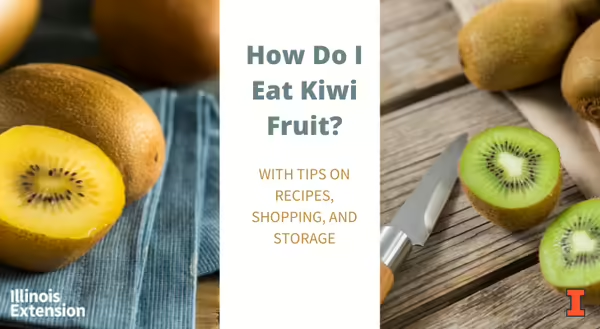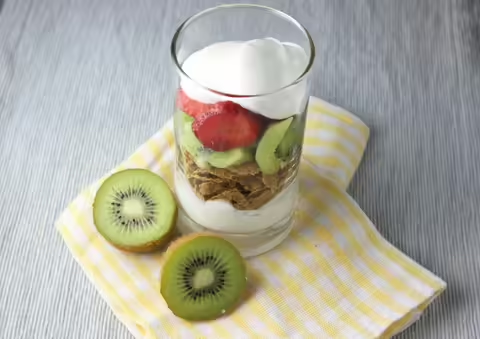
What is a food you never grew up eating, but now enjoy as an adult? There are several for me, including pears, asparagus, cauliflower, and kiwi fruit. I've had strawberry-kiwi flavored drinks, but never a fresh kiwi fruit until several years ago. I'm so glad I tried them, with their soft, sweet, and a little tart fruit with crunchy little black seeds.
One medium kiwi fruit contains around 40 calories, 10g carbohydrates, and 2g fiber, and contains vitamins and minerals, including vitamin K, vitamin C, potassium, and magnesium. Kiwi fruit are not a significant source of fat, sodium, or protein.
- Buy:
- Fresh: Look for fresh kiwi fruit that have smooth, firm outer skins. Avoid kiwi fruit with wrinkled skin or soft spots, which can indicate over-ripeness. Kiwi fruit comes in green and gold colors, which can make it fun to switch up for different pops of color.
- Dried: Like many dried fruits, dried kiwi fruit makes for a convenient, portable snack. Find them dried with a sugar coating or freeze-dried without sugar. Try both and see what taste and texture you prefer.
- Juiced: Some juice blends will add kiwi fruit. Look for those with 100% juice.
- Frozen: Check your freezer section for frozen fruit blends with kiwi fruit. Look for no-sugar-added brands, where available.
- Price: Fresh kiwi fruit averages about $2.18 per pound, according to the U.S. Department of Agriculture, They are somewhat expensive of a fruit, so check for sales or compare costs.
- Store: Store unpeeled kiwi fruit at room temperature. If the kiwi fruits feel soft when squeezed gently and have a sweet smell, they are ripe. Eat them within a day or two or refrigerate for longer storage. Hard kiwi fruits will usually ripen within a few days at room temperature. (If they do not ripen – which has happened to me before – add them to your compost.)
- Prepare: Wash the fuzzy skin of kiwi fruits before preparing. Eat the skin if you like; it's edible. Or remove the skin with a knife. I've also used a vegetable peeler to remove the skin. Or check out these how-to videos for other methods of preparing kiwi fruit:
- Peeling Kiwi Trick from Texas A&M AgriLife Extension (spoon method)
- How to Serve Kiwi Fruit from Utah State University Extension (egg slicer method)
- Preserve: Preserve kiwi fruits at home by making Strawberry-Kiwi Jam from the National Center for Home Food Preservation.
- Eat: Enjoy kiwi fruit raw as a snack, added to fruit salads, and blended into drinks.
- Food Science: Fresh kiwi fruit contains an enzyme called actinidin. (Other tropical fruits have similar enzymes, like bromelain in pineapple and papain in papaya.) If adding fresh kiwi fruit to gelatin salads or meat marinades, the enzyme begins to break down proteins, leaving the gelatin salad soupy and meats mushy. That is one reason the Kiwi Berry Parfait recipe below should be eaten soon after it's made.
- Body Science: Some people with latex allergies may find they react to eating kiwi fruit. Others who eat kiwi fruit may experience symptoms of Oral Allergy Syndrome, which is typically mild for most people.
Kiwi Berry Parfait | Print recipe
serves 2
2 kiwifruit, peeled and sliced
1 cup fresh (or thawed from frozen) strawberries, sliced
1 cup plain or vanilla yogurt
1/2 cup corn or bran flakes cereal
- Wash hands with soap and water.
- Gently rub fruit under cool running water.
- Use 10-12 ounce clear glass or plastic glasses.
- Layer kiwifruit, strawberries, yogurt, and cereal in glasses and serve.
Nutrition Facts (calculated with fat-free vanilla Greek yogurt and bran flakes cereal): 210 calories, 1g fat, 100mg sodium, 41g carbohydrates, 4g fiber, 11g protein
Recipe by Eat.Move.Save. from Illinois Extension
Resources:
- How to Peel a Kiwi (PDF), Louisiana State University, 2008
- Kiwifruit (English, Español), Iowa State University Extension and Outreach, Eat Smart, Spend Smart, 2017, 2021
- Kiwi, Oregon State University, Food Hero
Post originally published in 2017; content updated in 2022.
Healthy Eats and Repeat
How much difference is there between canned and frozen foods? How should you cook venison? When is the best time to buy avocados? Get answers to these questions as well as other tips, tutorials and recipes for common kitchen foods and items with University of Illinois Extension Nutrition & Wellness Educator Caitlin Mellendorf’s blog Healthy Eats and Repeat. Build your best life. Trust Extension to help.
Caitlin Mellendorf is an Illinois Extension Nutrition and Wellness Educator serving DeWitt, Macon and Piatt Counties in Central Illinois. She is a Registered Dietitian and her work focuses on helping community members gain the knowledge, skills and tools to live healthier, more nutritious lifestyles. This includes providing programs and answering questions about heart health, diabetes, food safety, food preservation, grocery shopping and cooking. You can reach Caitlin by email at chuth2@illinois.edu or call 217.877.6042. Check out her nutrition blog Healthy Eats and Repeats for seasonal recipes and of an exploration of common kitchen foods.
